DAL - Hospitality Management: Restaurant Field Research and Analysis
VerifiedAdded on 2022/11/17
|12
|3775
|271
Report
AI Summary
This report presents a comprehensive analysis of restaurant field research, focusing on food production management within the context of a new restaurant opening at Docklands Academy London (DAL). The report examines various aspects of food preparation, including different types of food, influences on food design, and principles of planning food preparation. It further delves into the methods of planning food preparation, resources required for food delivery (land, water, and forest), and procedures to ensure effective resource management. Standard Operating Procedures (SOPs) are discussed, highlighting their benefits in maintaining consistency and quality. The report also covers methods of monitoring food production, identifying deviations, and taking corrective actions to ensure a safe and efficient operation, ultimately aiming to meet customer needs and business expectations. The research includes case studies of various restaurants, providing comparative insights into their practices.
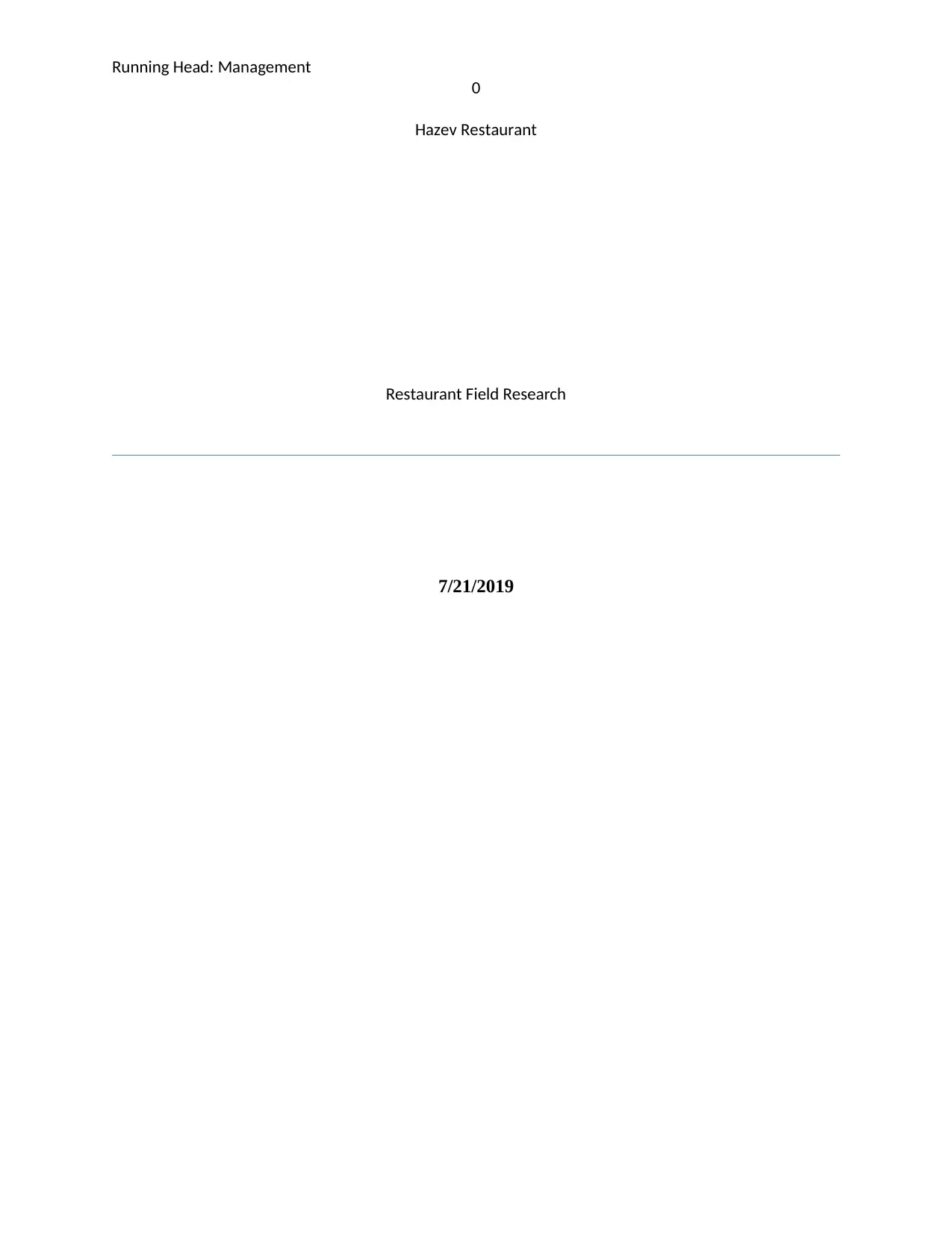
Running Head: Management
0
Hazev Restaurant
Restaurant Field Research
7/21/2019
0
Hazev Restaurant
Restaurant Field Research
7/21/2019
Paraphrase This Document
Need a fresh take? Get an instant paraphrase of this document with our AI Paraphraser
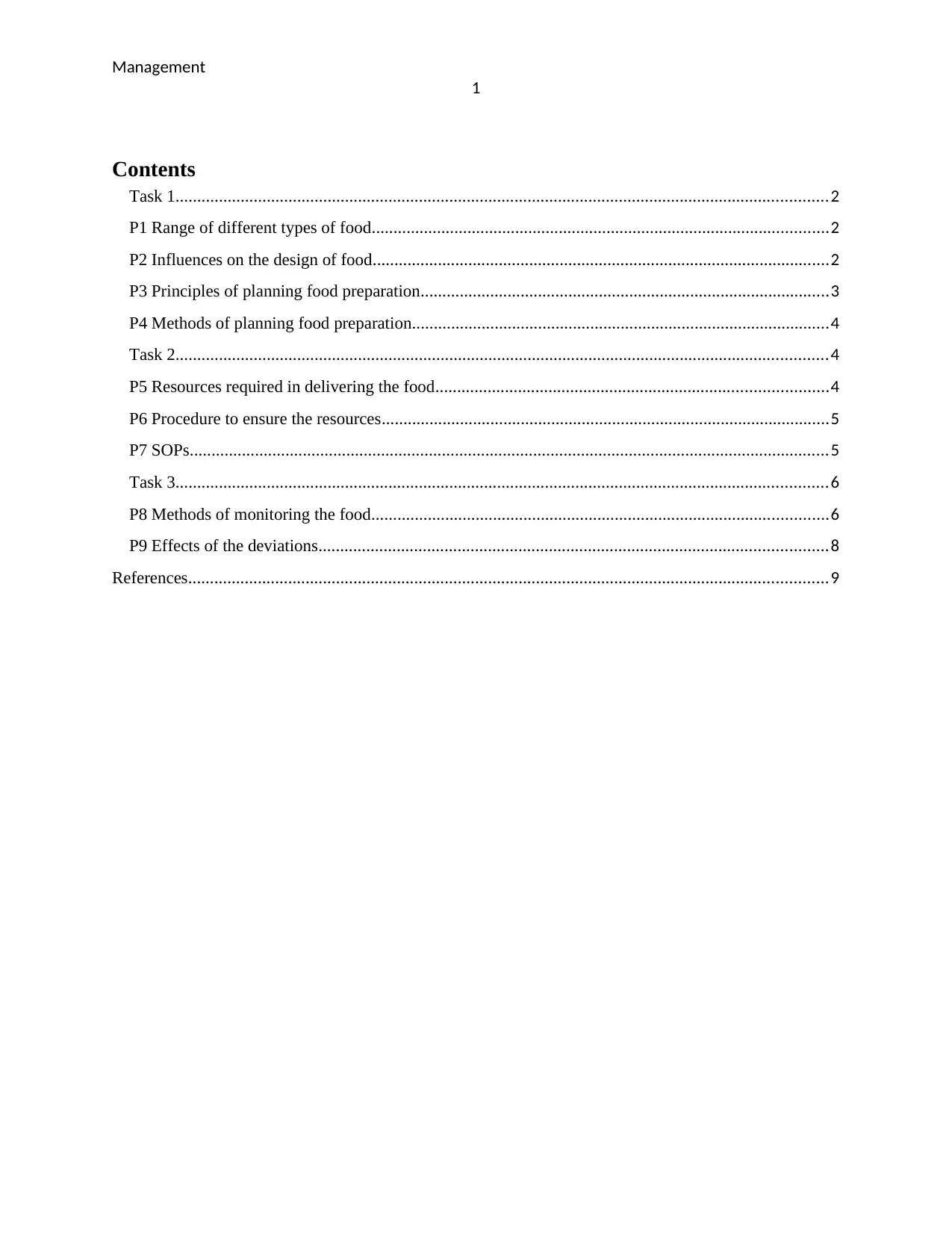
Management
1
Contents
Task 1......................................................................................................................................................2
P1 Range of different types of food.........................................................................................................2
P2 Influences on the design of food.........................................................................................................2
P3 Principles of planning food preparation..............................................................................................3
P4 Methods of planning food preparation................................................................................................4
Task 2......................................................................................................................................................4
P5 Resources required in delivering the food..........................................................................................4
P6 Procedure to ensure the resources.......................................................................................................5
P7 SOPs...................................................................................................................................................5
Task 3......................................................................................................................................................6
P8 Methods of monitoring the food.........................................................................................................6
P9 Effects of the deviations.....................................................................................................................8
References...................................................................................................................................................9
1
Contents
Task 1......................................................................................................................................................2
P1 Range of different types of food.........................................................................................................2
P2 Influences on the design of food.........................................................................................................2
P3 Principles of planning food preparation..............................................................................................3
P4 Methods of planning food preparation................................................................................................4
Task 2......................................................................................................................................................4
P5 Resources required in delivering the food..........................................................................................4
P6 Procedure to ensure the resources.......................................................................................................5
P7 SOPs...................................................................................................................................................5
Task 3......................................................................................................................................................6
P8 Methods of monitoring the food.........................................................................................................6
P9 Effects of the deviations.....................................................................................................................8
References...................................................................................................................................................9
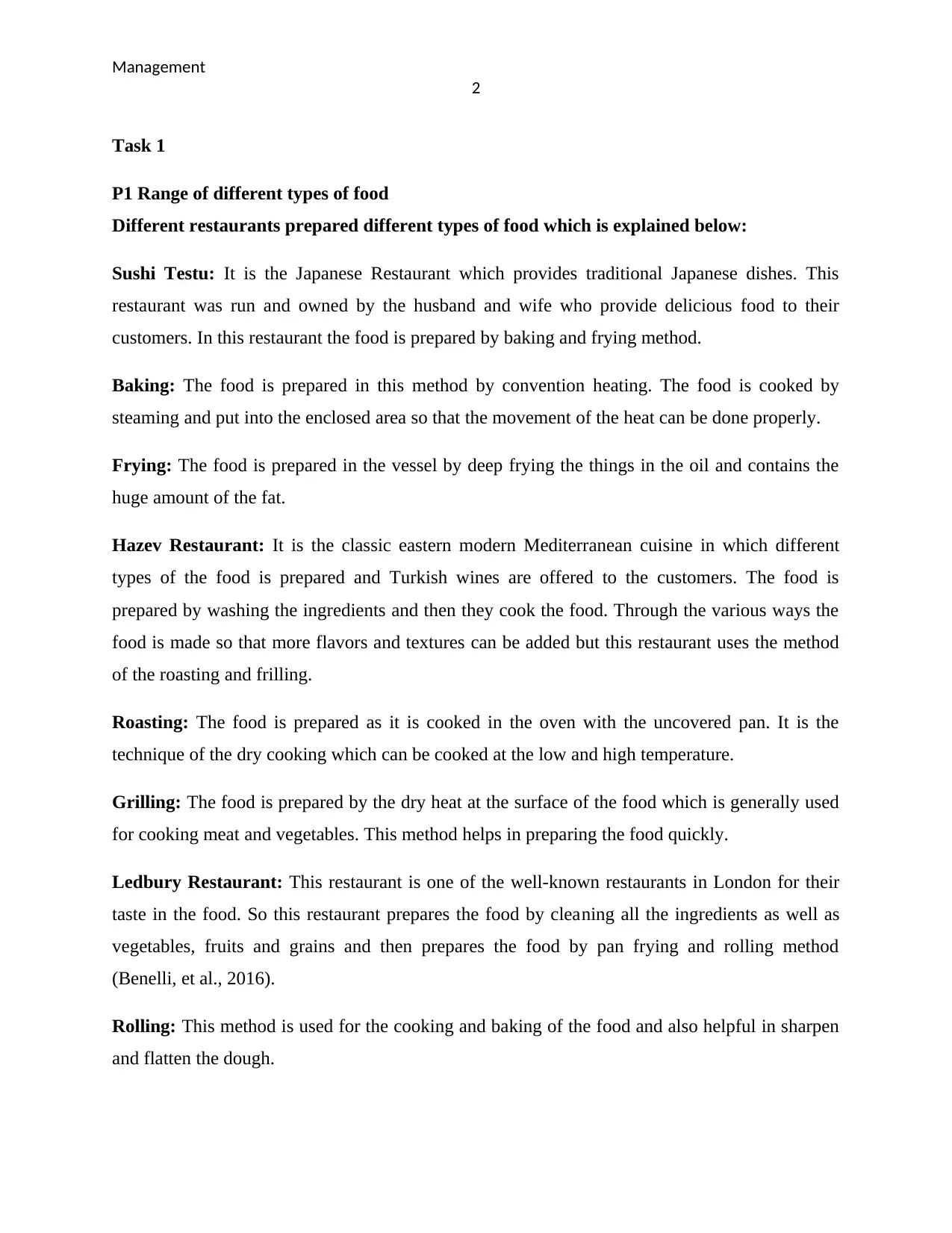
Management
2
Task 1
P1 Range of different types of food
Different restaurants prepared different types of food which is explained below:
Sushi Testu: It is the Japanese Restaurant which provides traditional Japanese dishes. This
restaurant was run and owned by the husband and wife who provide delicious food to their
customers. In this restaurant the food is prepared by baking and frying method.
Baking: The food is prepared in this method by convention heating. The food is cooked by
steaming and put into the enclosed area so that the movement of the heat can be done properly.
Frying: The food is prepared in the vessel by deep frying the things in the oil and contains the
huge amount of the fat.
Hazev Restaurant: It is the classic eastern modern Mediterranean cuisine in which different
types of the food is prepared and Turkish wines are offered to the customers. The food is
prepared by washing the ingredients and then they cook the food. Through the various ways the
food is made so that more flavors and textures can be added but this restaurant uses the method
of the roasting and frilling.
Roasting: The food is prepared as it is cooked in the oven with the uncovered pan. It is the
technique of the dry cooking which can be cooked at the low and high temperature.
Grilling: The food is prepared by the dry heat at the surface of the food which is generally used
for cooking meat and vegetables. This method helps in preparing the food quickly.
Ledbury Restaurant: This restaurant is one of the well-known restaurants in London for their
taste in the food. So this restaurant prepares the food by cleaning all the ingredients as well as
vegetables, fruits and grains and then prepares the food by pan frying and rolling method
(Benelli, et al., 2016).
Rolling: This method is used for the cooking and baking of the food and also helpful in sharpen
and flatten the dough.
2
Task 1
P1 Range of different types of food
Different restaurants prepared different types of food which is explained below:
Sushi Testu: It is the Japanese Restaurant which provides traditional Japanese dishes. This
restaurant was run and owned by the husband and wife who provide delicious food to their
customers. In this restaurant the food is prepared by baking and frying method.
Baking: The food is prepared in this method by convention heating. The food is cooked by
steaming and put into the enclosed area so that the movement of the heat can be done properly.
Frying: The food is prepared in the vessel by deep frying the things in the oil and contains the
huge amount of the fat.
Hazev Restaurant: It is the classic eastern modern Mediterranean cuisine in which different
types of the food is prepared and Turkish wines are offered to the customers. The food is
prepared by washing the ingredients and then they cook the food. Through the various ways the
food is made so that more flavors and textures can be added but this restaurant uses the method
of the roasting and frilling.
Roasting: The food is prepared as it is cooked in the oven with the uncovered pan. It is the
technique of the dry cooking which can be cooked at the low and high temperature.
Grilling: The food is prepared by the dry heat at the surface of the food which is generally used
for cooking meat and vegetables. This method helps in preparing the food quickly.
Ledbury Restaurant: This restaurant is one of the well-known restaurants in London for their
taste in the food. So this restaurant prepares the food by cleaning all the ingredients as well as
vegetables, fruits and grains and then prepares the food by pan frying and rolling method
(Benelli, et al., 2016).
Rolling: This method is used for the cooking and baking of the food and also helpful in sharpen
and flatten the dough.
⊘ This is a preview!⊘
Do you want full access?
Subscribe today to unlock all pages.

Trusted by 1+ million students worldwide
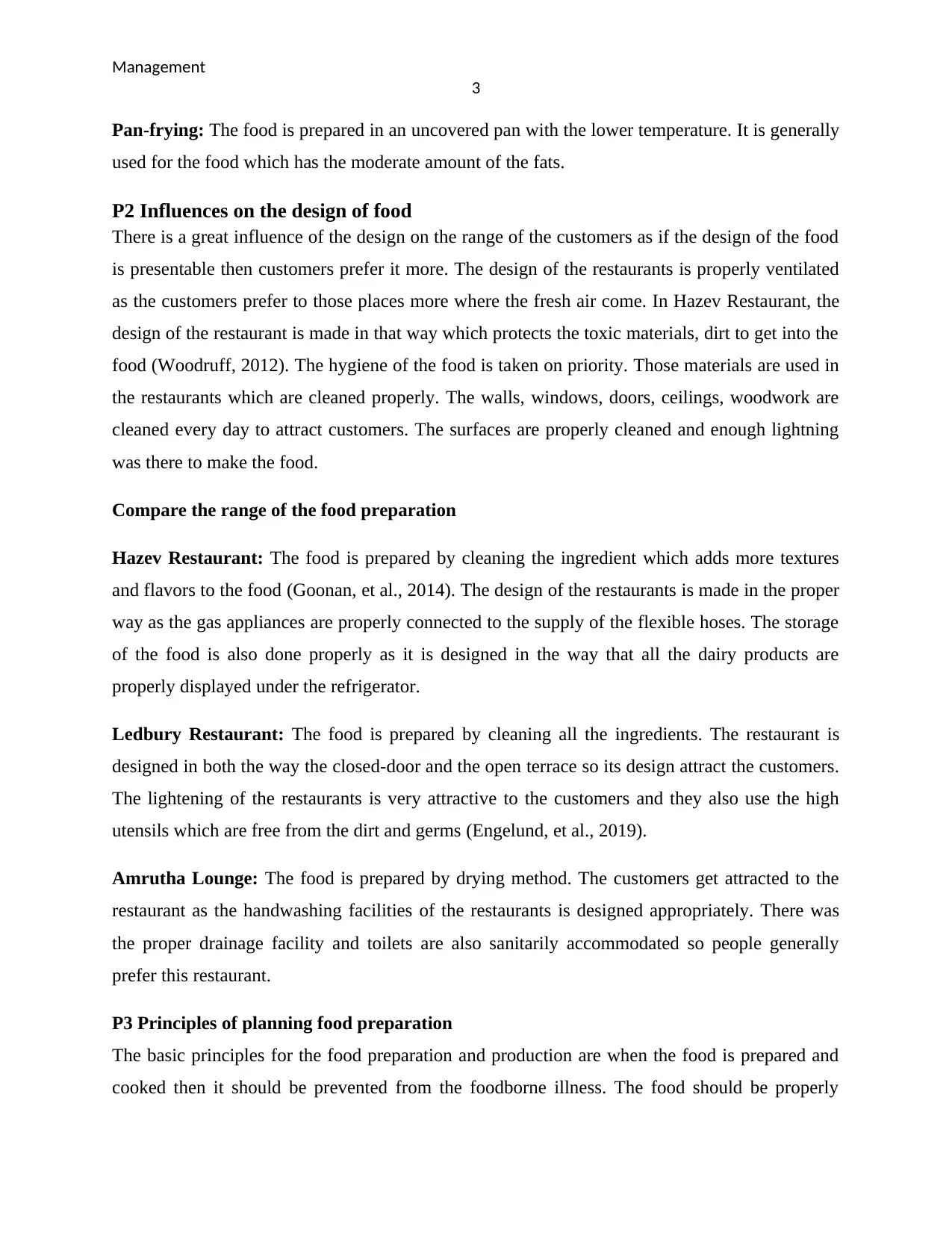
Management
3
Pan-frying: The food is prepared in an uncovered pan with the lower temperature. It is generally
used for the food which has the moderate amount of the fats.
P2 Influences on the design of food
There is a great influence of the design on the range of the customers as if the design of the food
is presentable then customers prefer it more. The design of the restaurants is properly ventilated
as the customers prefer to those places more where the fresh air come. In Hazev Restaurant, the
design of the restaurant is made in that way which protects the toxic materials, dirt to get into the
food (Woodruff, 2012). The hygiene of the food is taken on priority. Those materials are used in
the restaurants which are cleaned properly. The walls, windows, doors, ceilings, woodwork are
cleaned every day to attract customers. The surfaces are properly cleaned and enough lightning
was there to make the food.
Compare the range of the food preparation
Hazev Restaurant: The food is prepared by cleaning the ingredient which adds more textures
and flavors to the food (Goonan, et al., 2014). The design of the restaurants is made in the proper
way as the gas appliances are properly connected to the supply of the flexible hoses. The storage
of the food is also done properly as it is designed in the way that all the dairy products are
properly displayed under the refrigerator.
Ledbury Restaurant: The food is prepared by cleaning all the ingredients. The restaurant is
designed in both the way the closed-door and the open terrace so its design attract the customers.
The lightening of the restaurants is very attractive to the customers and they also use the high
utensils which are free from the dirt and germs (Engelund, et al., 2019).
Amrutha Lounge: The food is prepared by drying method. The customers get attracted to the
restaurant as the handwashing facilities of the restaurants is designed appropriately. There was
the proper drainage facility and toilets are also sanitarily accommodated so people generally
prefer this restaurant.
P3 Principles of planning food preparation
The basic principles for the food preparation and production are when the food is prepared and
cooked then it should be prevented from the foodborne illness. The food should be properly
3
Pan-frying: The food is prepared in an uncovered pan with the lower temperature. It is generally
used for the food which has the moderate amount of the fats.
P2 Influences on the design of food
There is a great influence of the design on the range of the customers as if the design of the food
is presentable then customers prefer it more. The design of the restaurants is properly ventilated
as the customers prefer to those places more where the fresh air come. In Hazev Restaurant, the
design of the restaurant is made in that way which protects the toxic materials, dirt to get into the
food (Woodruff, 2012). The hygiene of the food is taken on priority. Those materials are used in
the restaurants which are cleaned properly. The walls, windows, doors, ceilings, woodwork are
cleaned every day to attract customers. The surfaces are properly cleaned and enough lightning
was there to make the food.
Compare the range of the food preparation
Hazev Restaurant: The food is prepared by cleaning the ingredient which adds more textures
and flavors to the food (Goonan, et al., 2014). The design of the restaurants is made in the proper
way as the gas appliances are properly connected to the supply of the flexible hoses. The storage
of the food is also done properly as it is designed in the way that all the dairy products are
properly displayed under the refrigerator.
Ledbury Restaurant: The food is prepared by cleaning all the ingredients. The restaurant is
designed in both the way the closed-door and the open terrace so its design attract the customers.
The lightening of the restaurants is very attractive to the customers and they also use the high
utensils which are free from the dirt and germs (Engelund, et al., 2019).
Amrutha Lounge: The food is prepared by drying method. The customers get attracted to the
restaurant as the handwashing facilities of the restaurants is designed appropriately. There was
the proper drainage facility and toilets are also sanitarily accommodated so people generally
prefer this restaurant.
P3 Principles of planning food preparation
The basic principles for the food preparation and production are when the food is prepared and
cooked then it should be prevented from the foodborne illness. The food should be properly
Paraphrase This Document
Need a fresh take? Get an instant paraphrase of this document with our AI Paraphraser
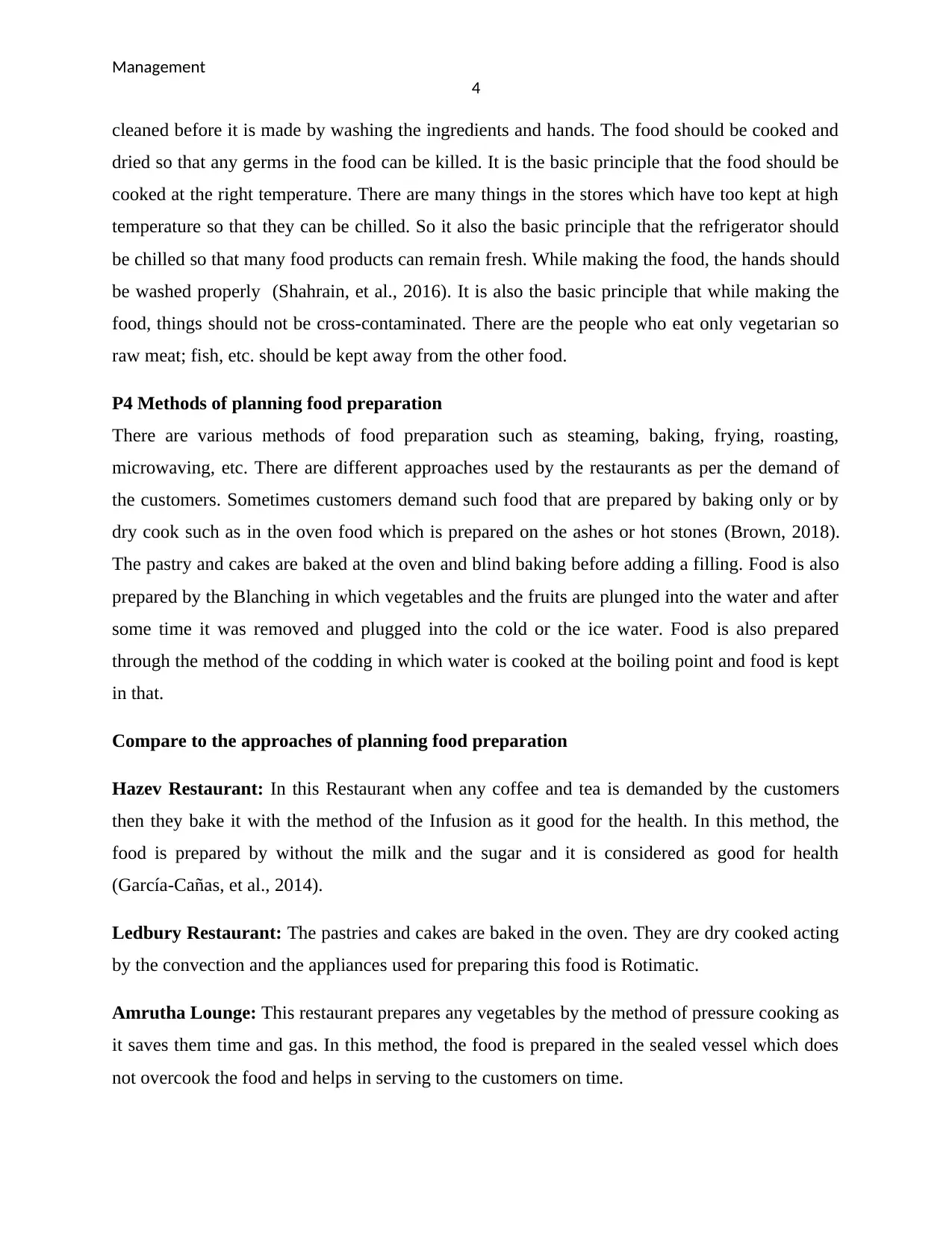
Management
4
cleaned before it is made by washing the ingredients and hands. The food should be cooked and
dried so that any germs in the food can be killed. It is the basic principle that the food should be
cooked at the right temperature. There are many things in the stores which have too kept at high
temperature so that they can be chilled. So it also the basic principle that the refrigerator should
be chilled so that many food products can remain fresh. While making the food, the hands should
be washed properly (Shahrain, et al., 2016). It is also the basic principle that while making the
food, things should not be cross-contaminated. There are the people who eat only vegetarian so
raw meat; fish, etc. should be kept away from the other food.
P4 Methods of planning food preparation
There are various methods of food preparation such as steaming, baking, frying, roasting,
microwaving, etc. There are different approaches used by the restaurants as per the demand of
the customers. Sometimes customers demand such food that are prepared by baking only or by
dry cook such as in the oven food which is prepared on the ashes or hot stones (Brown, 2018).
The pastry and cakes are baked at the oven and blind baking before adding a filling. Food is also
prepared by the Blanching in which vegetables and the fruits are plunged into the water and after
some time it was removed and plugged into the cold or the ice water. Food is also prepared
through the method of the codding in which water is cooked at the boiling point and food is kept
in that.
Compare to the approaches of planning food preparation
Hazev Restaurant: In this Restaurant when any coffee and tea is demanded by the customers
then they bake it with the method of the Infusion as it good for the health. In this method, the
food is prepared by without the milk and the sugar and it is considered as good for health
(García‐Cañas, et al., 2014).
Ledbury Restaurant: The pastries and cakes are baked in the oven. They are dry cooked acting
by the convection and the appliances used for preparing this food is Rotimatic.
Amrutha Lounge: This restaurant prepares any vegetables by the method of pressure cooking as
it saves them time and gas. In this method, the food is prepared in the sealed vessel which does
not overcook the food and helps in serving to the customers on time.
4
cleaned before it is made by washing the ingredients and hands. The food should be cooked and
dried so that any germs in the food can be killed. It is the basic principle that the food should be
cooked at the right temperature. There are many things in the stores which have too kept at high
temperature so that they can be chilled. So it also the basic principle that the refrigerator should
be chilled so that many food products can remain fresh. While making the food, the hands should
be washed properly (Shahrain, et al., 2016). It is also the basic principle that while making the
food, things should not be cross-contaminated. There are the people who eat only vegetarian so
raw meat; fish, etc. should be kept away from the other food.
P4 Methods of planning food preparation
There are various methods of food preparation such as steaming, baking, frying, roasting,
microwaving, etc. There are different approaches used by the restaurants as per the demand of
the customers. Sometimes customers demand such food that are prepared by baking only or by
dry cook such as in the oven food which is prepared on the ashes or hot stones (Brown, 2018).
The pastry and cakes are baked at the oven and blind baking before adding a filling. Food is also
prepared by the Blanching in which vegetables and the fruits are plunged into the water and after
some time it was removed and plugged into the cold or the ice water. Food is also prepared
through the method of the codding in which water is cooked at the boiling point and food is kept
in that.
Compare to the approaches of planning food preparation
Hazev Restaurant: In this Restaurant when any coffee and tea is demanded by the customers
then they bake it with the method of the Infusion as it good for the health. In this method, the
food is prepared by without the milk and the sugar and it is considered as good for health
(García‐Cañas, et al., 2014).
Ledbury Restaurant: The pastries and cakes are baked in the oven. They are dry cooked acting
by the convection and the appliances used for preparing this food is Rotimatic.
Amrutha Lounge: This restaurant prepares any vegetables by the method of pressure cooking as
it saves them time and gas. In this method, the food is prepared in the sealed vessel which does
not overcook the food and helps in serving to the customers on time.
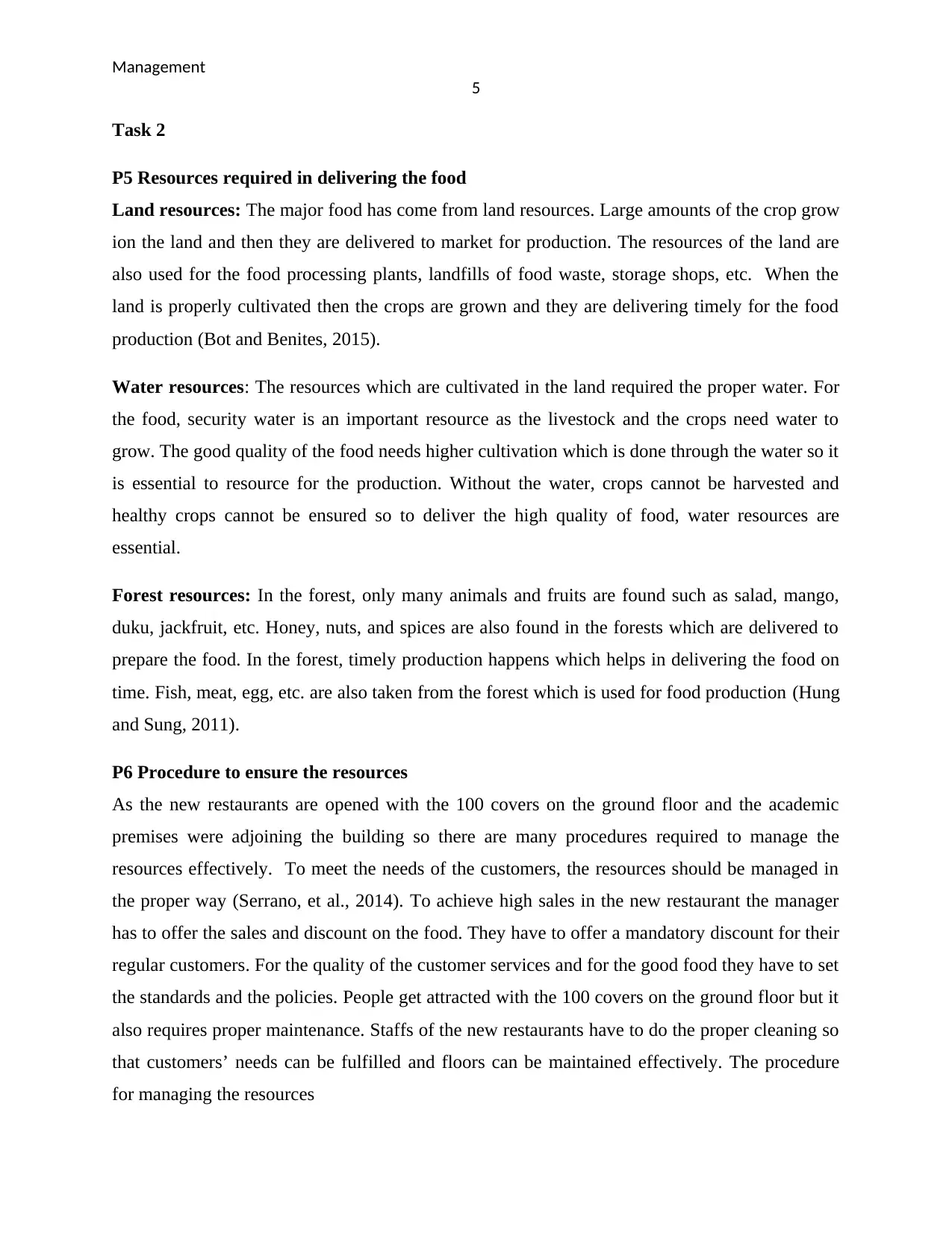
Management
5
Task 2
P5 Resources required in delivering the food
Land resources: The major food has come from land resources. Large amounts of the crop grow
ion the land and then they are delivered to market for production. The resources of the land are
also used for the food processing plants, landfills of food waste, storage shops, etc. When the
land is properly cultivated then the crops are grown and they are delivering timely for the food
production (Bot and Benites, 2015).
Water resources: The resources which are cultivated in the land required the proper water. For
the food, security water is an important resource as the livestock and the crops need water to
grow. The good quality of the food needs higher cultivation which is done through the water so it
is essential to resource for the production. Without the water, crops cannot be harvested and
healthy crops cannot be ensured so to deliver the high quality of food, water resources are
essential.
Forest resources: In the forest, only many animals and fruits are found such as salad, mango,
duku, jackfruit, etc. Honey, nuts, and spices are also found in the forests which are delivered to
prepare the food. In the forest, timely production happens which helps in delivering the food on
time. Fish, meat, egg, etc. are also taken from the forest which is used for food production (Hung
and Sung, 2011).
P6 Procedure to ensure the resources
As the new restaurants are opened with the 100 covers on the ground floor and the academic
premises were adjoining the building so there are many procedures required to manage the
resources effectively. To meet the needs of the customers, the resources should be managed in
the proper way (Serrano, et al., 2014). To achieve high sales in the new restaurant the manager
has to offer the sales and discount on the food. They have to offer a mandatory discount for their
regular customers. For the quality of the customer services and for the good food they have to set
the standards and the policies. People get attracted with the 100 covers on the ground floor but it
also requires proper maintenance. Staffs of the new restaurants have to do the proper cleaning so
that customers’ needs can be fulfilled and floors can be maintained effectively. The procedure
for managing the resources
5
Task 2
P5 Resources required in delivering the food
Land resources: The major food has come from land resources. Large amounts of the crop grow
ion the land and then they are delivered to market for production. The resources of the land are
also used for the food processing plants, landfills of food waste, storage shops, etc. When the
land is properly cultivated then the crops are grown and they are delivering timely for the food
production (Bot and Benites, 2015).
Water resources: The resources which are cultivated in the land required the proper water. For
the food, security water is an important resource as the livestock and the crops need water to
grow. The good quality of the food needs higher cultivation which is done through the water so it
is essential to resource for the production. Without the water, crops cannot be harvested and
healthy crops cannot be ensured so to deliver the high quality of food, water resources are
essential.
Forest resources: In the forest, only many animals and fruits are found such as salad, mango,
duku, jackfruit, etc. Honey, nuts, and spices are also found in the forests which are delivered to
prepare the food. In the forest, timely production happens which helps in delivering the food on
time. Fish, meat, egg, etc. are also taken from the forest which is used for food production (Hung
and Sung, 2011).
P6 Procedure to ensure the resources
As the new restaurants are opened with the 100 covers on the ground floor and the academic
premises were adjoining the building so there are many procedures required to manage the
resources effectively. To meet the needs of the customers, the resources should be managed in
the proper way (Serrano, et al., 2014). To achieve high sales in the new restaurant the manager
has to offer the sales and discount on the food. They have to offer a mandatory discount for their
regular customers. For the quality of the customer services and for the good food they have to set
the standards and the policies. People get attracted with the 100 covers on the ground floor but it
also requires proper maintenance. Staffs of the new restaurants have to do the proper cleaning so
that customers’ needs can be fulfilled and floors can be maintained effectively. The procedure
for managing the resources
⊘ This is a preview!⊘
Do you want full access?
Subscribe today to unlock all pages.

Trusted by 1+ million students worldwide
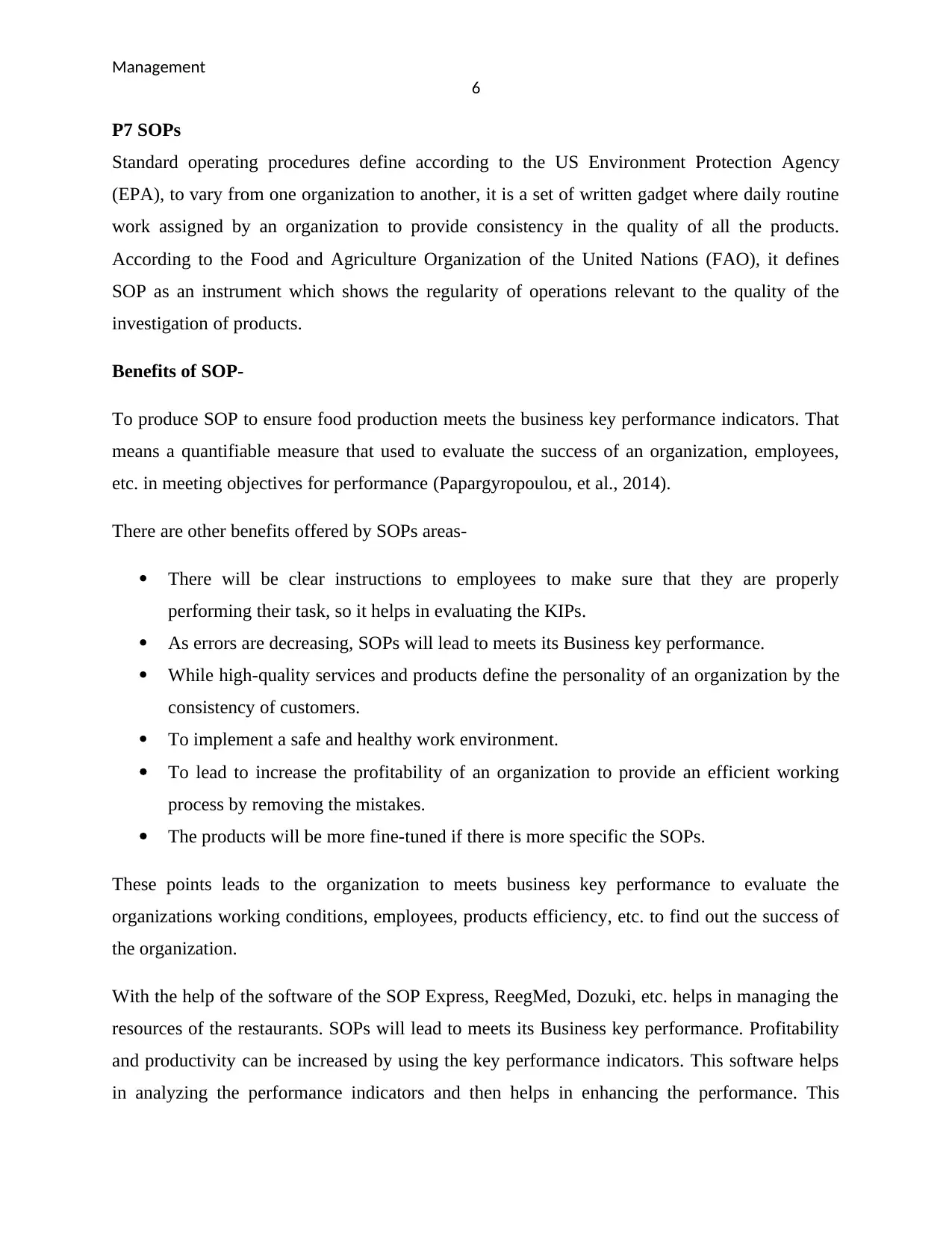
Management
6
P7 SOPs
Standard operating procedures define according to the US Environment Protection Agency
(EPA), to vary from one organization to another, it is a set of written gadget where daily routine
work assigned by an organization to provide consistency in the quality of all the products.
According to the Food and Agriculture Organization of the United Nations (FAO), it defines
SOP as an instrument which shows the regularity of operations relevant to the quality of the
investigation of products.
Benefits of SOP-
To produce SOP to ensure food production meets the business key performance indicators. That
means a quantifiable measure that used to evaluate the success of an organization, employees,
etc. in meeting objectives for performance (Papargyropoulou, et al., 2014).
There are other benefits offered by SOPs areas-
There will be clear instructions to employees to make sure that they are properly
performing their task, so it helps in evaluating the KIPs.
As errors are decreasing, SOPs will lead to meets its Business key performance.
While high-quality services and products define the personality of an organization by the
consistency of customers.
To implement a safe and healthy work environment.
To lead to increase the profitability of an organization to provide an efficient working
process by removing the mistakes.
The products will be more fine-tuned if there is more specific the SOPs.
These points leads to the organization to meets business key performance to evaluate the
organizations working conditions, employees, products efficiency, etc. to find out the success of
the organization.
With the help of the software of the SOP Express, ReegMed, Dozuki, etc. helps in managing the
resources of the restaurants. SOPs will lead to meets its Business key performance. Profitability
and productivity can be increased by using the key performance indicators. This software helps
in analyzing the performance indicators and then helps in enhancing the performance. This
6
P7 SOPs
Standard operating procedures define according to the US Environment Protection Agency
(EPA), to vary from one organization to another, it is a set of written gadget where daily routine
work assigned by an organization to provide consistency in the quality of all the products.
According to the Food and Agriculture Organization of the United Nations (FAO), it defines
SOP as an instrument which shows the regularity of operations relevant to the quality of the
investigation of products.
Benefits of SOP-
To produce SOP to ensure food production meets the business key performance indicators. That
means a quantifiable measure that used to evaluate the success of an organization, employees,
etc. in meeting objectives for performance (Papargyropoulou, et al., 2014).
There are other benefits offered by SOPs areas-
There will be clear instructions to employees to make sure that they are properly
performing their task, so it helps in evaluating the KIPs.
As errors are decreasing, SOPs will lead to meets its Business key performance.
While high-quality services and products define the personality of an organization by the
consistency of customers.
To implement a safe and healthy work environment.
To lead to increase the profitability of an organization to provide an efficient working
process by removing the mistakes.
The products will be more fine-tuned if there is more specific the SOPs.
These points leads to the organization to meets business key performance to evaluate the
organizations working conditions, employees, products efficiency, etc. to find out the success of
the organization.
With the help of the software of the SOP Express, ReegMed, Dozuki, etc. helps in managing the
resources of the restaurants. SOPs will lead to meets its Business key performance. Profitability
and productivity can be increased by using the key performance indicators. This software helps
in analyzing the performance indicators and then helps in enhancing the performance. This
Paraphrase This Document
Need a fresh take? Get an instant paraphrase of this document with our AI Paraphraser
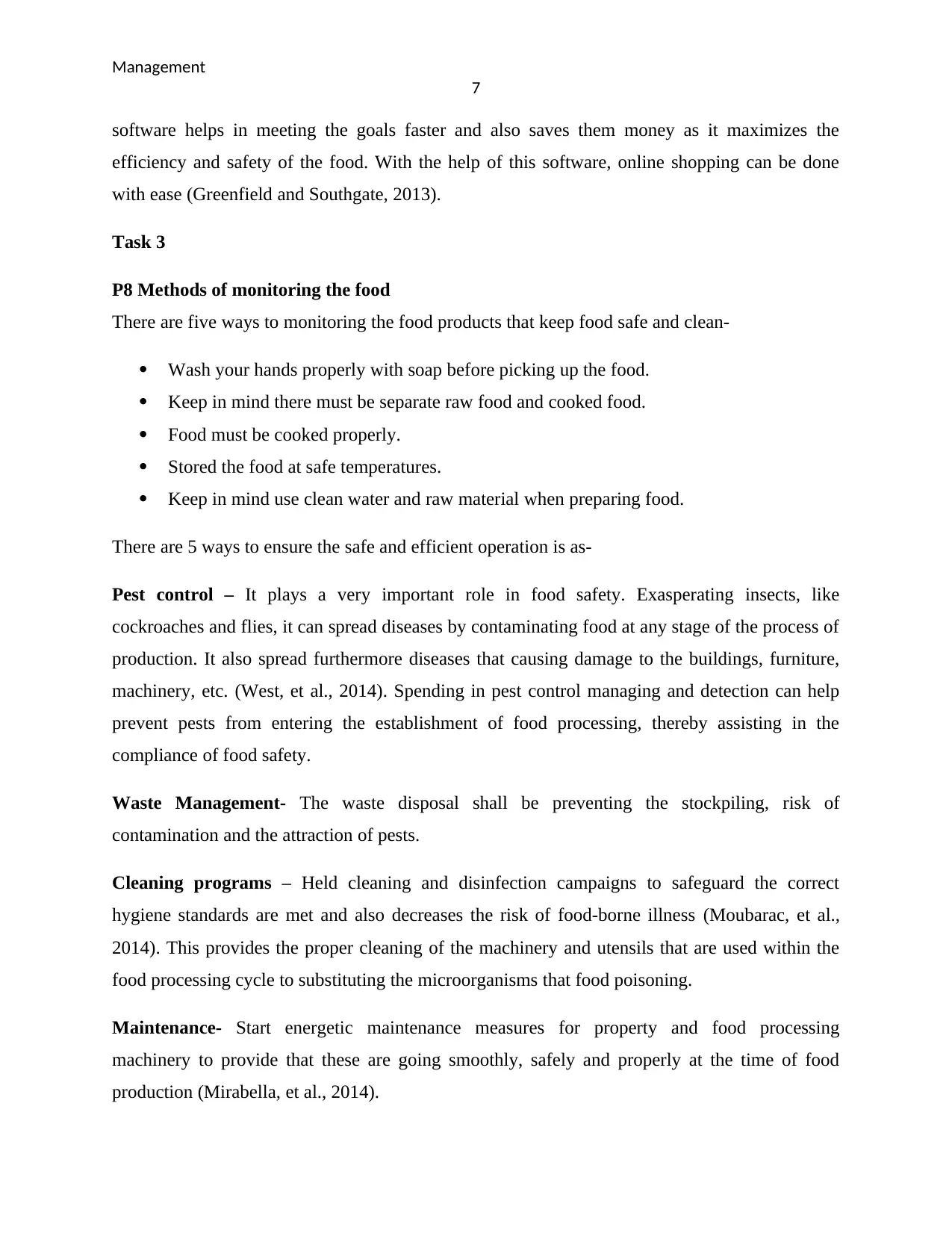
Management
7
software helps in meeting the goals faster and also saves them money as it maximizes the
efficiency and safety of the food. With the help of this software, online shopping can be done
with ease (Greenfield and Southgate, 2013).
Task 3
P8 Methods of monitoring the food
There are five ways to monitoring the food products that keep food safe and clean-
Wash your hands properly with soap before picking up the food.
Keep in mind there must be separate raw food and cooked food.
Food must be cooked properly.
Stored the food at safe temperatures.
Keep in mind use clean water and raw material when preparing food.
There are 5 ways to ensure the safe and efficient operation is as-
Pest control – It plays a very important role in food safety. Exasperating insects, like
cockroaches and flies, it can spread diseases by contaminating food at any stage of the process of
production. It also spread furthermore diseases that causing damage to the buildings, furniture,
machinery, etc. (West, et al., 2014). Spending in pest control managing and detection can help
prevent pests from entering the establishment of food processing, thereby assisting in the
compliance of food safety.
Waste Management- The waste disposal shall be preventing the stockpiling, risk of
contamination and the attraction of pests.
Cleaning programs – Held cleaning and disinfection campaigns to safeguard the correct
hygiene standards are met and also decreases the risk of food-borne illness (Moubarac, et al.,
2014). This provides the proper cleaning of the machinery and utensils that are used within the
food processing cycle to substituting the microorganisms that food poisoning.
Maintenance- Start energetic maintenance measures for property and food processing
machinery to provide that these are going smoothly, safely and properly at the time of food
production (Mirabella, et al., 2014).
7
software helps in meeting the goals faster and also saves them money as it maximizes the
efficiency and safety of the food. With the help of this software, online shopping can be done
with ease (Greenfield and Southgate, 2013).
Task 3
P8 Methods of monitoring the food
There are five ways to monitoring the food products that keep food safe and clean-
Wash your hands properly with soap before picking up the food.
Keep in mind there must be separate raw food and cooked food.
Food must be cooked properly.
Stored the food at safe temperatures.
Keep in mind use clean water and raw material when preparing food.
There are 5 ways to ensure the safe and efficient operation is as-
Pest control – It plays a very important role in food safety. Exasperating insects, like
cockroaches and flies, it can spread diseases by contaminating food at any stage of the process of
production. It also spread furthermore diseases that causing damage to the buildings, furniture,
machinery, etc. (West, et al., 2014). Spending in pest control managing and detection can help
prevent pests from entering the establishment of food processing, thereby assisting in the
compliance of food safety.
Waste Management- The waste disposal shall be preventing the stockpiling, risk of
contamination and the attraction of pests.
Cleaning programs – Held cleaning and disinfection campaigns to safeguard the correct
hygiene standards are met and also decreases the risk of food-borne illness (Moubarac, et al.,
2014). This provides the proper cleaning of the machinery and utensils that are used within the
food processing cycle to substituting the microorganisms that food poisoning.
Maintenance- Start energetic maintenance measures for property and food processing
machinery to provide that these are going smoothly, safely and properly at the time of food
production (Mirabella, et al., 2014).
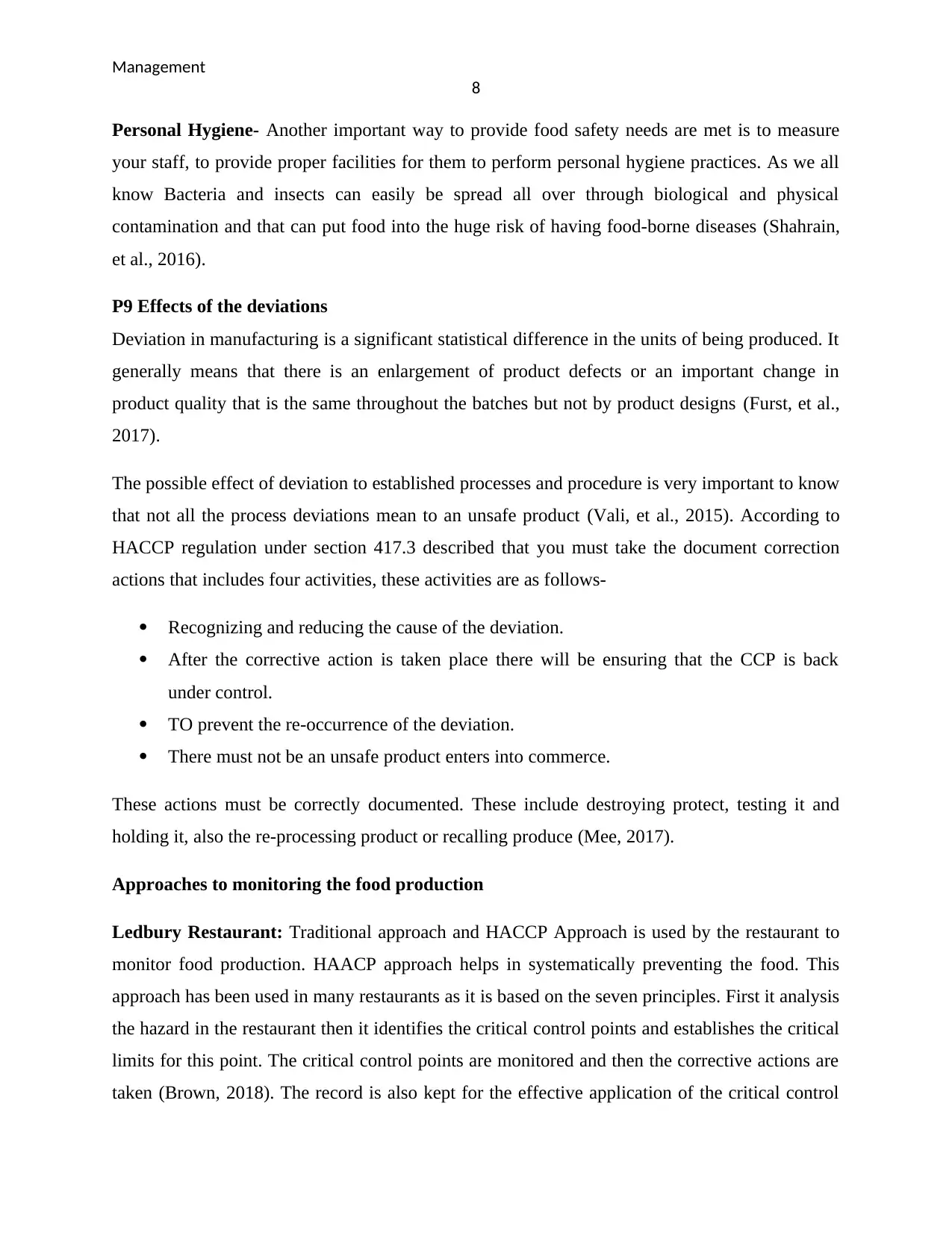
Management
8
Personal Hygiene- Another important way to provide food safety needs are met is to measure
your staff, to provide proper facilities for them to perform personal hygiene practices. As we all
know Bacteria and insects can easily be spread all over through biological and physical
contamination and that can put food into the huge risk of having food-borne diseases (Shahrain,
et al., 2016).
P9 Effects of the deviations
Deviation in manufacturing is a significant statistical difference in the units of being produced. It
generally means that there is an enlargement of product defects or an important change in
product quality that is the same throughout the batches but not by product designs (Furst, et al.,
2017).
The possible effect of deviation to established processes and procedure is very important to know
that not all the process deviations mean to an unsafe product (Vali, et al., 2015). According to
HACCP regulation under section 417.3 described that you must take the document correction
actions that includes four activities, these activities are as follows-
Recognizing and reducing the cause of the deviation.
After the corrective action is taken place there will be ensuring that the CCP is back
under control.
TO prevent the re-occurrence of the deviation.
There must not be an unsafe product enters into commerce.
These actions must be correctly documented. These include destroying protect, testing it and
holding it, also the re-processing product or recalling produce (Mee, 2017).
Approaches to monitoring the food production
Ledbury Restaurant: Traditional approach and HACCP Approach is used by the restaurant to
monitor food production. HAACP approach helps in systematically preventing the food. This
approach has been used in many restaurants as it is based on the seven principles. First it analysis
the hazard in the restaurant then it identifies the critical control points and establishes the critical
limits for this point. The critical control points are monitored and then the corrective actions are
taken (Brown, 2018). The record is also kept for the effective application of the critical control
8
Personal Hygiene- Another important way to provide food safety needs are met is to measure
your staff, to provide proper facilities for them to perform personal hygiene practices. As we all
know Bacteria and insects can easily be spread all over through biological and physical
contamination and that can put food into the huge risk of having food-borne diseases (Shahrain,
et al., 2016).
P9 Effects of the deviations
Deviation in manufacturing is a significant statistical difference in the units of being produced. It
generally means that there is an enlargement of product defects or an important change in
product quality that is the same throughout the batches but not by product designs (Furst, et al.,
2017).
The possible effect of deviation to established processes and procedure is very important to know
that not all the process deviations mean to an unsafe product (Vali, et al., 2015). According to
HACCP regulation under section 417.3 described that you must take the document correction
actions that includes four activities, these activities are as follows-
Recognizing and reducing the cause of the deviation.
After the corrective action is taken place there will be ensuring that the CCP is back
under control.
TO prevent the re-occurrence of the deviation.
There must not be an unsafe product enters into commerce.
These actions must be correctly documented. These include destroying protect, testing it and
holding it, also the re-processing product or recalling produce (Mee, 2017).
Approaches to monitoring the food production
Ledbury Restaurant: Traditional approach and HACCP Approach is used by the restaurant to
monitor food production. HAACP approach helps in systematically preventing the food. This
approach has been used in many restaurants as it is based on the seven principles. First it analysis
the hazard in the restaurant then it identifies the critical control points and establishes the critical
limits for this point. The critical control points are monitored and then the corrective actions are
taken (Brown, 2018). The record is also kept for the effective application of the critical control
⊘ This is a preview!⊘
Do you want full access?
Subscribe today to unlock all pages.

Trusted by 1+ million students worldwide
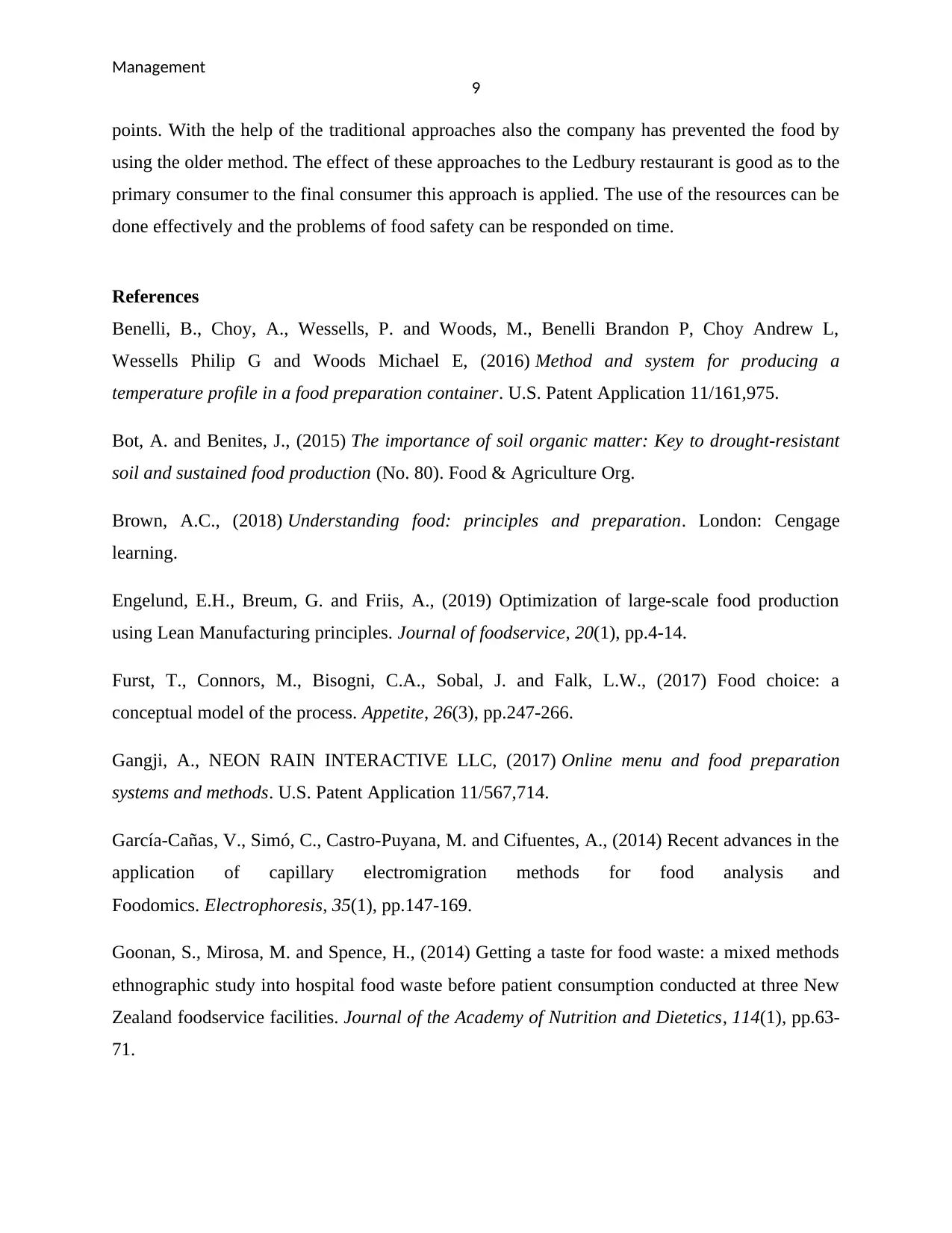
Management
9
points. With the help of the traditional approaches also the company has prevented the food by
using the older method. The effect of these approaches to the Ledbury restaurant is good as to the
primary consumer to the final consumer this approach is applied. The use of the resources can be
done effectively and the problems of food safety can be responded on time.
References
Benelli, B., Choy, A., Wessells, P. and Woods, M., Benelli Brandon P, Choy Andrew L,
Wessells Philip G and Woods Michael E, (2016) Method and system for producing a
temperature profile in a food preparation container. U.S. Patent Application 11/161,975.
Bot, A. and Benites, J., (2015) The importance of soil organic matter: Key to drought-resistant
soil and sustained food production (No. 80). Food & Agriculture Org.
Brown, A.C., (2018) Understanding food: principles and preparation. London: Cengage
learning.
Engelund, E.H., Breum, G. and Friis, A., (2019) Optimization of large‐scale food production
using Lean Manufacturing principles. Journal of foodservice, 20(1), pp.4-14.
Furst, T., Connors, M., Bisogni, C.A., Sobal, J. and Falk, L.W., (2017) Food choice: a
conceptual model of the process. Appetite, 26(3), pp.247-266.
Gangji, A., NEON RAIN INTERACTIVE LLC, (2017) Online menu and food preparation
systems and methods. U.S. Patent Application 11/567,714.
García‐Cañas, V., Simó, C., Castro‐Puyana, M. and Cifuentes, A., (2014) Recent advances in the
application of capillary electromigration methods for food analysis and
Foodomics. Electrophoresis, 35(1), pp.147-169.
Goonan, S., Mirosa, M. and Spence, H., (2014) Getting a taste for food waste: a mixed methods
ethnographic study into hospital food waste before patient consumption conducted at three New
Zealand foodservice facilities. Journal of the Academy of Nutrition and Dietetics, 114(1), pp.63-
71.
9
points. With the help of the traditional approaches also the company has prevented the food by
using the older method. The effect of these approaches to the Ledbury restaurant is good as to the
primary consumer to the final consumer this approach is applied. The use of the resources can be
done effectively and the problems of food safety can be responded on time.
References
Benelli, B., Choy, A., Wessells, P. and Woods, M., Benelli Brandon P, Choy Andrew L,
Wessells Philip G and Woods Michael E, (2016) Method and system for producing a
temperature profile in a food preparation container. U.S. Patent Application 11/161,975.
Bot, A. and Benites, J., (2015) The importance of soil organic matter: Key to drought-resistant
soil and sustained food production (No. 80). Food & Agriculture Org.
Brown, A.C., (2018) Understanding food: principles and preparation. London: Cengage
learning.
Engelund, E.H., Breum, G. and Friis, A., (2019) Optimization of large‐scale food production
using Lean Manufacturing principles. Journal of foodservice, 20(1), pp.4-14.
Furst, T., Connors, M., Bisogni, C.A., Sobal, J. and Falk, L.W., (2017) Food choice: a
conceptual model of the process. Appetite, 26(3), pp.247-266.
Gangji, A., NEON RAIN INTERACTIVE LLC, (2017) Online menu and food preparation
systems and methods. U.S. Patent Application 11/567,714.
García‐Cañas, V., Simó, C., Castro‐Puyana, M. and Cifuentes, A., (2014) Recent advances in the
application of capillary electromigration methods for food analysis and
Foodomics. Electrophoresis, 35(1), pp.147-169.
Goonan, S., Mirosa, M. and Spence, H., (2014) Getting a taste for food waste: a mixed methods
ethnographic study into hospital food waste before patient consumption conducted at three New
Zealand foodservice facilities. Journal of the Academy of Nutrition and Dietetics, 114(1), pp.63-
71.
Paraphrase This Document
Need a fresh take? Get an instant paraphrase of this document with our AI Paraphraser
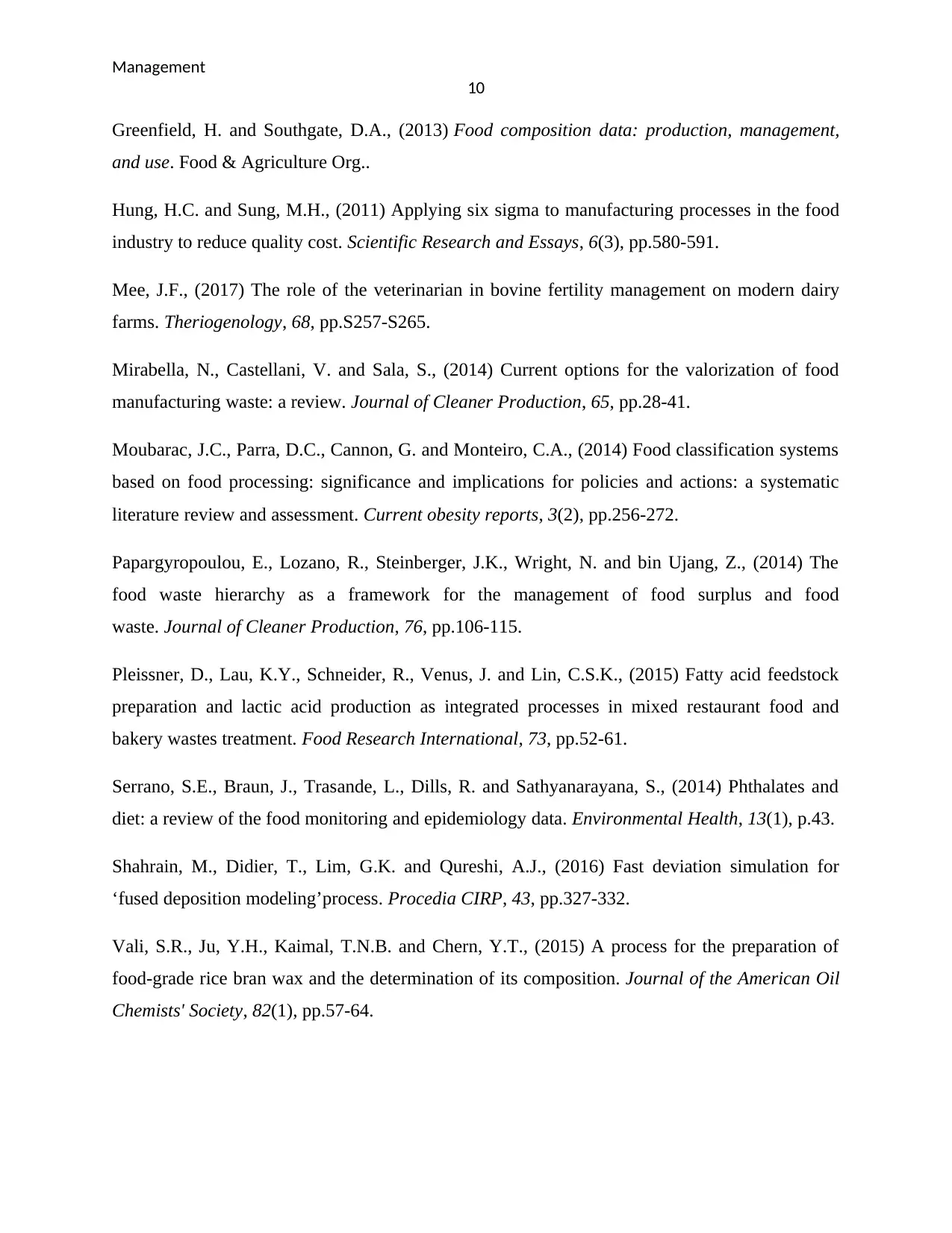
Management
10
Greenfield, H. and Southgate, D.A., (2013) Food composition data: production, management,
and use. Food & Agriculture Org..
Hung, H.C. and Sung, M.H., (2011) Applying six sigma to manufacturing processes in the food
industry to reduce quality cost. Scientific Research and Essays, 6(3), pp.580-591.
Mee, J.F., (2017) The role of the veterinarian in bovine fertility management on modern dairy
farms. Theriogenology, 68, pp.S257-S265.
Mirabella, N., Castellani, V. and Sala, S., (2014) Current options for the valorization of food
manufacturing waste: a review. Journal of Cleaner Production, 65, pp.28-41.
Moubarac, J.C., Parra, D.C., Cannon, G. and Monteiro, C.A., (2014) Food classification systems
based on food processing: significance and implications for policies and actions: a systematic
literature review and assessment. Current obesity reports, 3(2), pp.256-272.
Papargyropoulou, E., Lozano, R., Steinberger, J.K., Wright, N. and bin Ujang, Z., (2014) The
food waste hierarchy as a framework for the management of food surplus and food
waste. Journal of Cleaner Production, 76, pp.106-115.
Pleissner, D., Lau, K.Y., Schneider, R., Venus, J. and Lin, C.S.K., (2015) Fatty acid feedstock
preparation and lactic acid production as integrated processes in mixed restaurant food and
bakery wastes treatment. Food Research International, 73, pp.52-61.
Serrano, S.E., Braun, J., Trasande, L., Dills, R. and Sathyanarayana, S., (2014) Phthalates and
diet: a review of the food monitoring and epidemiology data. Environmental Health, 13(1), p.43.
Shahrain, M., Didier, T., Lim, G.K. and Qureshi, A.J., (2016) Fast deviation simulation for
‘fused deposition modeling’process. Procedia CIRP, 43, pp.327-332.
Vali, S.R., Ju, Y.H., Kaimal, T.N.B. and Chern, Y.T., (2015) A process for the preparation of
food-grade rice bran wax and the determination of its composition. Journal of the American Oil
Chemists' Society, 82(1), pp.57-64.
10
Greenfield, H. and Southgate, D.A., (2013) Food composition data: production, management,
and use. Food & Agriculture Org..
Hung, H.C. and Sung, M.H., (2011) Applying six sigma to manufacturing processes in the food
industry to reduce quality cost. Scientific Research and Essays, 6(3), pp.580-591.
Mee, J.F., (2017) The role of the veterinarian in bovine fertility management on modern dairy
farms. Theriogenology, 68, pp.S257-S265.
Mirabella, N., Castellani, V. and Sala, S., (2014) Current options for the valorization of food
manufacturing waste: a review. Journal of Cleaner Production, 65, pp.28-41.
Moubarac, J.C., Parra, D.C., Cannon, G. and Monteiro, C.A., (2014) Food classification systems
based on food processing: significance and implications for policies and actions: a systematic
literature review and assessment. Current obesity reports, 3(2), pp.256-272.
Papargyropoulou, E., Lozano, R., Steinberger, J.K., Wright, N. and bin Ujang, Z., (2014) The
food waste hierarchy as a framework for the management of food surplus and food
waste. Journal of Cleaner Production, 76, pp.106-115.
Pleissner, D., Lau, K.Y., Schneider, R., Venus, J. and Lin, C.S.K., (2015) Fatty acid feedstock
preparation and lactic acid production as integrated processes in mixed restaurant food and
bakery wastes treatment. Food Research International, 73, pp.52-61.
Serrano, S.E., Braun, J., Trasande, L., Dills, R. and Sathyanarayana, S., (2014) Phthalates and
diet: a review of the food monitoring and epidemiology data. Environmental Health, 13(1), p.43.
Shahrain, M., Didier, T., Lim, G.K. and Qureshi, A.J., (2016) Fast deviation simulation for
‘fused deposition modeling’process. Procedia CIRP, 43, pp.327-332.
Vali, S.R., Ju, Y.H., Kaimal, T.N.B. and Chern, Y.T., (2015) A process for the preparation of
food-grade rice bran wax and the determination of its composition. Journal of the American Oil
Chemists' Society, 82(1), pp.57-64.
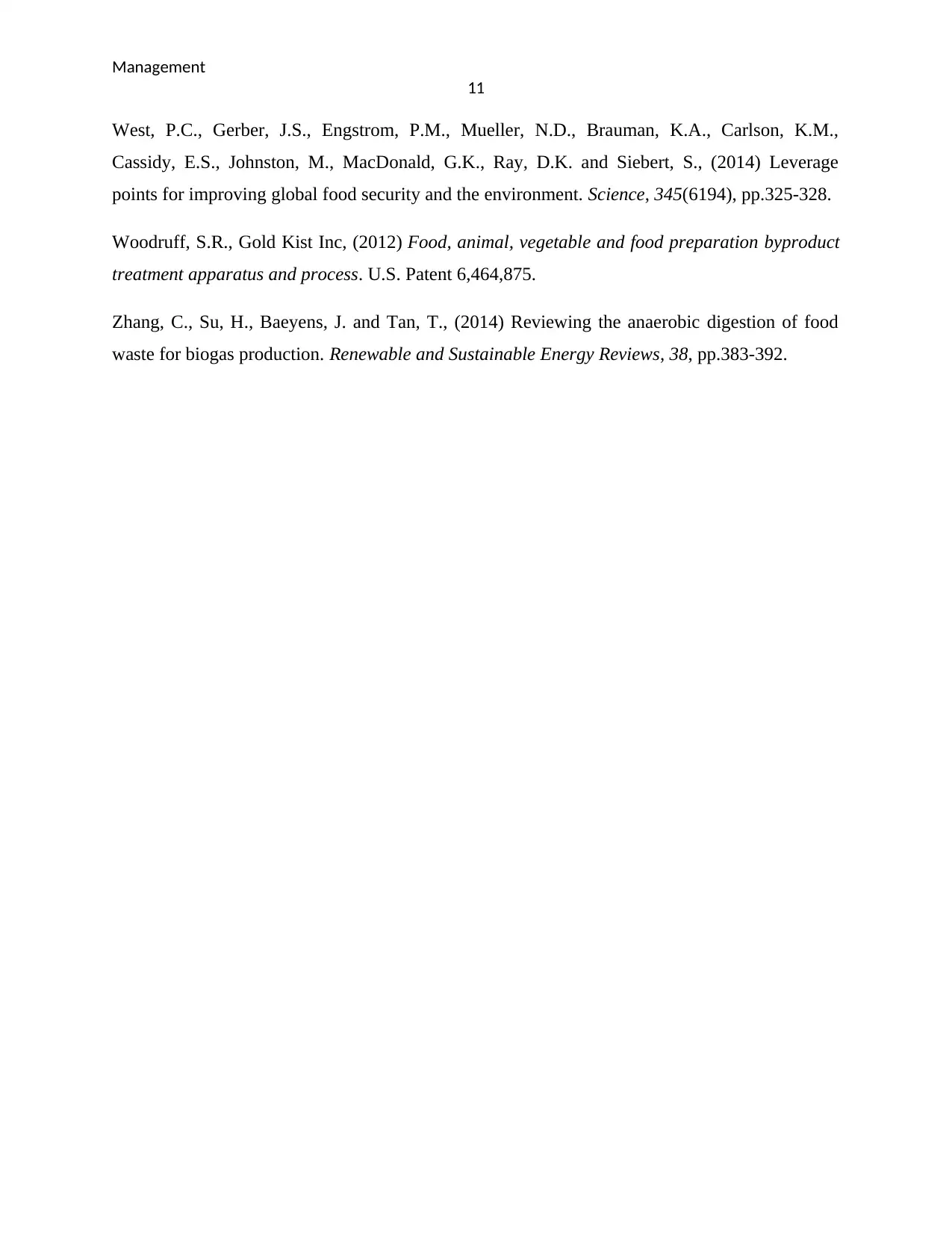
Management
11
West, P.C., Gerber, J.S., Engstrom, P.M., Mueller, N.D., Brauman, K.A., Carlson, K.M.,
Cassidy, E.S., Johnston, M., MacDonald, G.K., Ray, D.K. and Siebert, S., (2014) Leverage
points for improving global food security and the environment. Science, 345(6194), pp.325-328.
Woodruff, S.R., Gold Kist Inc, (2012) Food, animal, vegetable and food preparation byproduct
treatment apparatus and process. U.S. Patent 6,464,875.
Zhang, C., Su, H., Baeyens, J. and Tan, T., (2014) Reviewing the anaerobic digestion of food
waste for biogas production. Renewable and Sustainable Energy Reviews, 38, pp.383-392.
11
West, P.C., Gerber, J.S., Engstrom, P.M., Mueller, N.D., Brauman, K.A., Carlson, K.M.,
Cassidy, E.S., Johnston, M., MacDonald, G.K., Ray, D.K. and Siebert, S., (2014) Leverage
points for improving global food security and the environment. Science, 345(6194), pp.325-328.
Woodruff, S.R., Gold Kist Inc, (2012) Food, animal, vegetable and food preparation byproduct
treatment apparatus and process. U.S. Patent 6,464,875.
Zhang, C., Su, H., Baeyens, J. and Tan, T., (2014) Reviewing the anaerobic digestion of food
waste for biogas production. Renewable and Sustainable Energy Reviews, 38, pp.383-392.
⊘ This is a preview!⊘
Do you want full access?
Subscribe today to unlock all pages.

Trusted by 1+ million students worldwide
1 out of 12
Related Documents
Your All-in-One AI-Powered Toolkit for Academic Success.
+13062052269
info@desklib.com
Available 24*7 on WhatsApp / Email
![[object Object]](/_next/static/media/star-bottom.7253800d.svg)
Unlock your academic potential
Copyright © 2020–2025 A2Z Services. All Rights Reserved. Developed and managed by ZUCOL.





